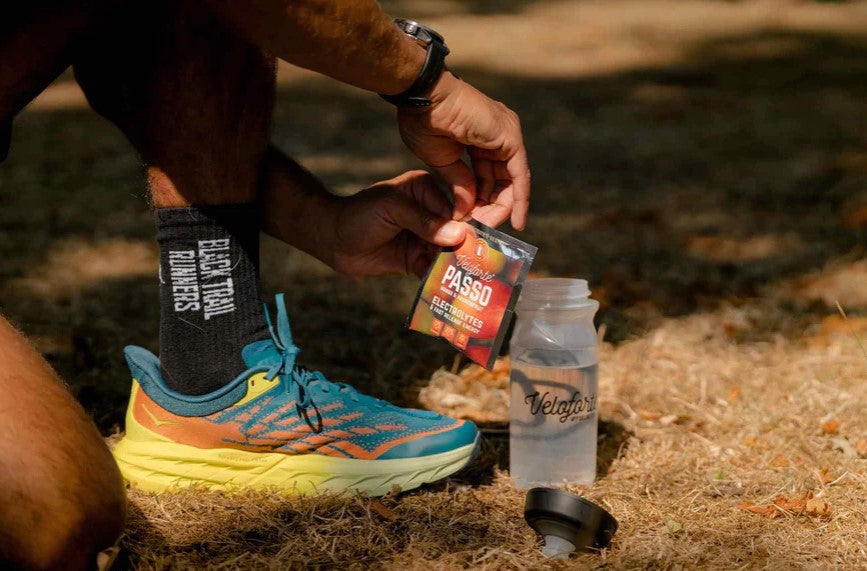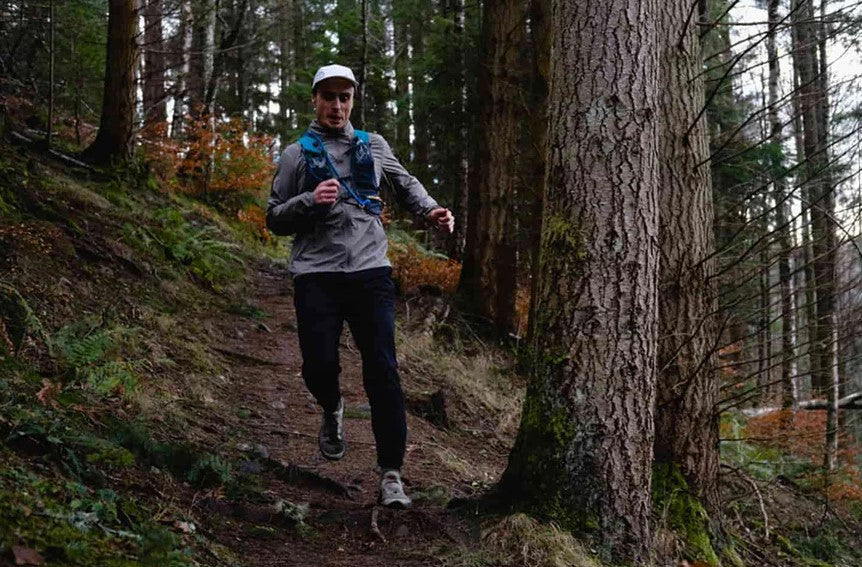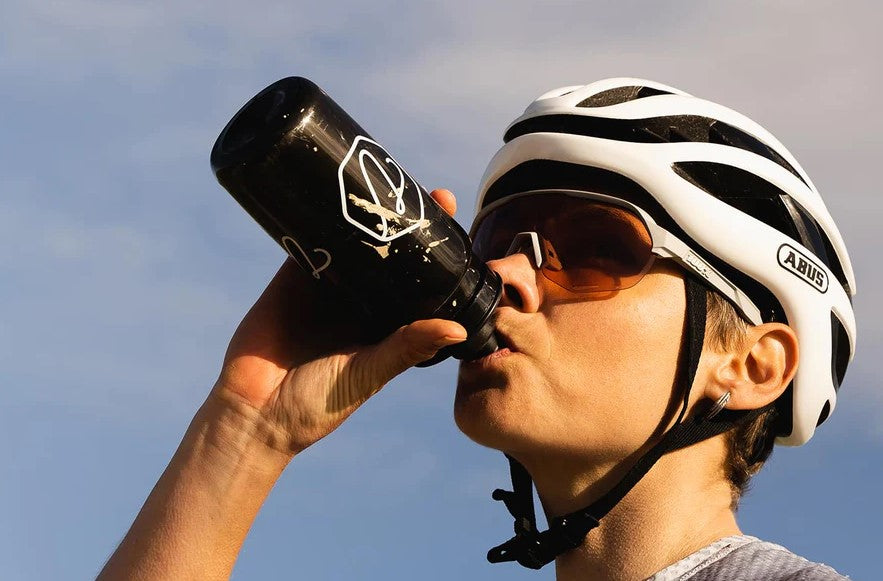Running Hydration: Tips and Best Drinks Guide

Cast your eyes around at the start of any major running event and you’ll notice a sea of runners clutching water bottles. That’s enough to tell you that the runners understand the importance of good hydration.
However, there’s more to effective running hydration than glugging two litres of water on the morning of your race. And getting your fluid intake right can make a huge difference to how well you perform and how happy you run.
To help you get your running hydration strategy dialled, here’s Veloforte’s top tips for developing better drinking habits.
What happens when you’re dehydrated on a run?
Varying levels of dehydration will impact your runs in different ways. But you can guarantee one thing: a lack of fluids equals some very unhelpful effects:
Performance suffers
Just 1% dehydration negatively affects the body; at 4% dehydration, your capacity for muscular work is hampered. By the time you hit 5% dehydration you could see a 30% reduction in performance – that’s potentially the difference between a 45-minute 10k and crossing the finish line in just under an hour.

Decision making is impaired
Studies show that even as little as 2% dehydration can impact cognitive performance. That’s a big problem when you need to calculate pace, make smart decisions about when to fuel, or even know when it’s time to stick on a jacket during ultras.
Form can become ragged
One area most affected by dehydration is motor coordination. Holding that PB-perfect running form gets tougher when you’re under-hydrated.
Perception of effort rises
When you’re dehydrated your blood volume decreases so your heart has to work harder. This means your heart rate, metabolic rate and breathing rate can all increase. Your brain will let you know when that happens, making running at your regular paces feel much harder.

The grumpiness descends
Hydration levels also affect our mood. Multiple studies show there’s a relationship between hydration anxiety, depression and emotional state. It’s why you might suddenly find yourself feeling negative during a run. It could be a sign you need to take on fluids.
More serious risks
At 5% heat exhaustion is a threat, at 7% you may suffer hallucinations. At 10%, you’re in dangerous territory with risks of circulatory collapse, heat stroke and worse.
How do you know when you should rehydrate?
Unless you’re taking on a Marathon des Sables-style desert ultra, reaching the most extreme levels of dehydration is highly unlikely. The body has a pretty good system for keeping you safely hydrated, it’s called thirst. Drinking to thirst is a great way to maintain your fluid levels.
However, if you become mildly-to-moderately dehydrated during a run, you might notice some of the following symptoms:
- Dry mouth
- Headache
- Poor concentration
- Increased heart rate
- Increased body temperature
- Muscle cramps
- Nausea
- Fatigue

How much should you drink before, during and after a run?
The NHS recommends drinking around 1.2 litres of fluid a day to replace normal water loss. Weight, height, age, conditions and intensity all affect your fluid requirements during runs. But as a rule of thumb, either drink to thirst or aim to drink around 150ml every 20 minutes.
If you’ve done a sweat test, aim to steadily replace at least 75% of the fluids lost. Aim to replace 150% of fluid lost through sweat one-to-four hours after your run as well as electrolytes, carbs, and protein for optimal recovery.

Other simple strategies you can use to monitor your hydration for running
Here are three great tools for spotting when you’re running low on fluids.
Thirst
When you’re becoming dehydrated, your body lets you know. Though you may only feel thirsty when you’re already slightly dehydrated. Drinking regularly from the start of your run can catch dehydration before it hits.
However, over-zealous drinking can have detrimental effects including GI issues, needing to stop for the toilet or, in severe cases, hyponatremia – a seriously low level of sodium in the blood.
The Pee Test
Next time you visit the toilet, check the colour of your urine. If it’s a pale straw colour, well done you. You’re nicely hydrated. If it’s bright yellow or orange, you need to drink more.
The Sweat-Loss Test
By weighing yourself before and after a run, you can more precisely calculate the amount of fluid you personally lose through sweat. And how much you need to drink during runs to stay hydrated.
How to calculate your sweat loss
- Weigh yourself in minimal clothing (or better still naked) before a 60-minute run.
- Weigh yourself again when you finish, remembering to remove any heavy sweaty-soaked kit.
- The difference between the two weights, minus any fluids you’ve drunk during your workout, is your sweat loss. Each kilo lost is equal to a litre of sweat.
- That gives you an indication of the fluid you need. It might not be possible to replace all of these fluids as you exercise but aim for at least 75%.
What is the best way to hydrate for running?
When it comes to hydration for marathon runners or organised races, you can use the regular water stations to top up regularly. However, some runners prefer to be masters of their own hydration destiny and carry their own water and electrolyte drinks. You’ll need to do this in training as well.

Fortunately there are plenty of options for carrying fluids on runs, including running bottle belts, hydration bladders and minimal ultra vests with pockets for soft flasks.
Types of hydration drinks for runners
There are an overwhelming number of drinks targeted at runners, all promising performance-enhancing benefits. With so much choice it can be confusing to work out which types constitute the best hydration drink for runners, particularly when some sports drinks are designed to provide energy too.
However, running drinks are broken down into three types, based on their concentration compared to the human body, or tonicity to give it a technical name.
The tonicity of a drink affects the amount of carbohydrates, electrolytes and fluids that enter your bloodstream and how quickly you can absorb them. Knowing a drink’s tonicity is crucial to how and when you use it.
The three commonly seen types of sports drinks are:
- Hypotonic – which has a lower concentration of fluid, sugars and salt than blood
- Isotonic – which has a similar concentration of fluid, sugars and salt to blood
- Hypertonic – which has a higher concentration of fluid, sugars and salt than blood

Best hydration drinks for runners
Water: For runs up to 60 minutes, in all but the hottest conditions, neat H2O has everything you need.
Electrolyte powders: Use these for longer runs, higher intensity sessions and hotter conditions where rapid hydration is your number one need. These are also best for day-to-day hydration and post-run fluid replacement.
Easy to mix in 500ml of water, Veloforte Electrolyte Powder uses a blend of real fruit, botanicals and nature's finest electrolytes in a delicious hypotonic mix that provides rapid rehydration and keeps your electrolytes in balance so you can perform at your best.

Energy drinks: Designed to deliver carbohydrates, energy drinks are often isotonic or hypertonic. That means they’re less useful as a rapid hydration tool and better suited to boosting energy. However, they can help with fluid intake as a part of your fuelling mix.
Veloforte’s Vivo and Attivo both replace lost electrolytes and provide a 22g of fast-acting energy. You can add these easily to your bottles, soft flasks or hydration bladder. The Attivo blend of wild strawberry and basil also has natural caffeine for an extra kick.

For more help on how to fuel your runs effectively, check out our guide to nutrition for long distance runners.
Bonus running hydration tips
- Drink little and often: Aim for 2-3 mouthfuls of water or electrolyte drink every 10-15 minutes during your run.
- Stay hydrated day-to-day: If you can start a run well hydrated, you’re already winning.
- Don’t over drink: Drinking too much can severely dilute sodium levels in the blood and cause bloating, nausea and in severe cases seizures and death.
- Replace lost salts: Using electrolyte drinks during runs and generally day-to-day, replaces sodium and lost electrolytes. That’s good for general health but it can also help prevent hyponatremia on your runs, by maintaining the balance of your body’s fluids.
- Sip it and see: Try out different hydration options in training. You don’t want to suffer dehydration or stomach pain on race day so sussing out what works through trial and error is important.
![]()
Fuel your next run, naturally Veloforte exists to help active people fuel better. 100% natural, hand-crafted nutrition with award-winning recipes and breakthrough flavours.






